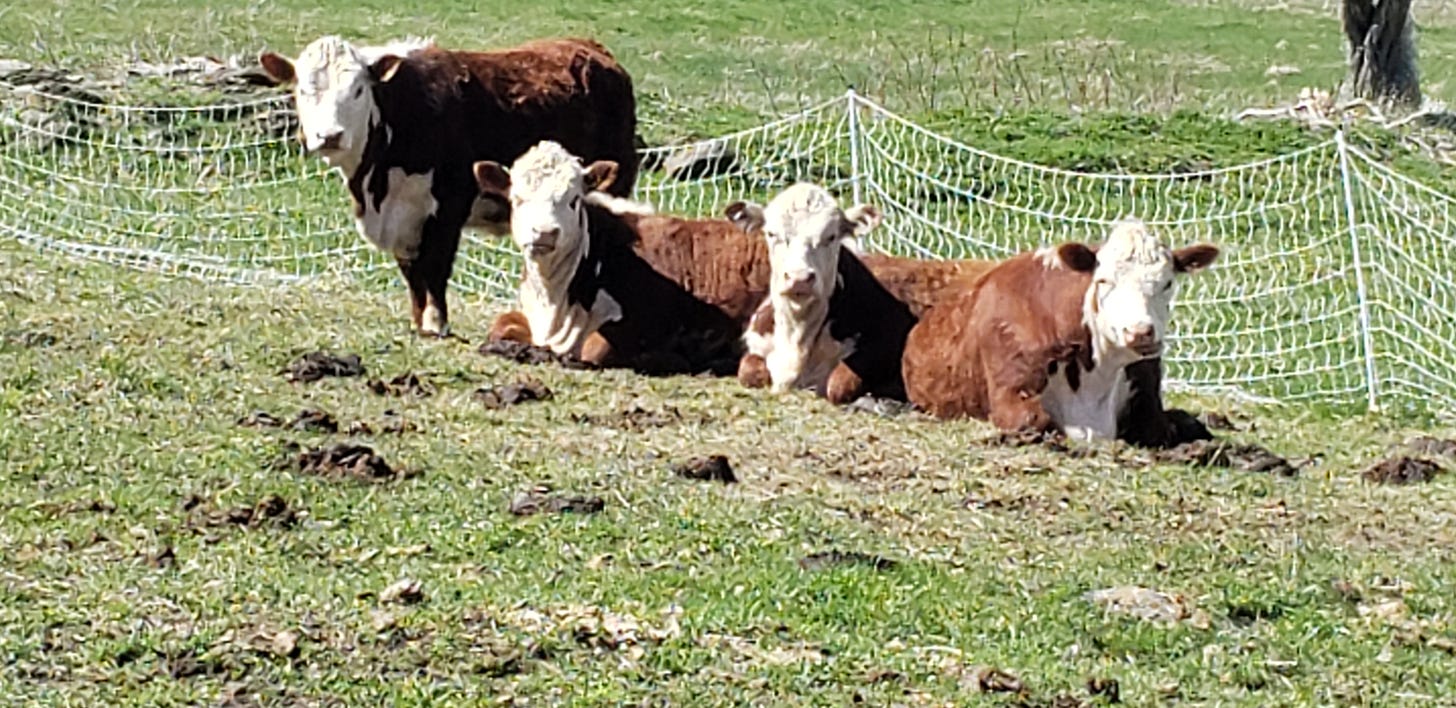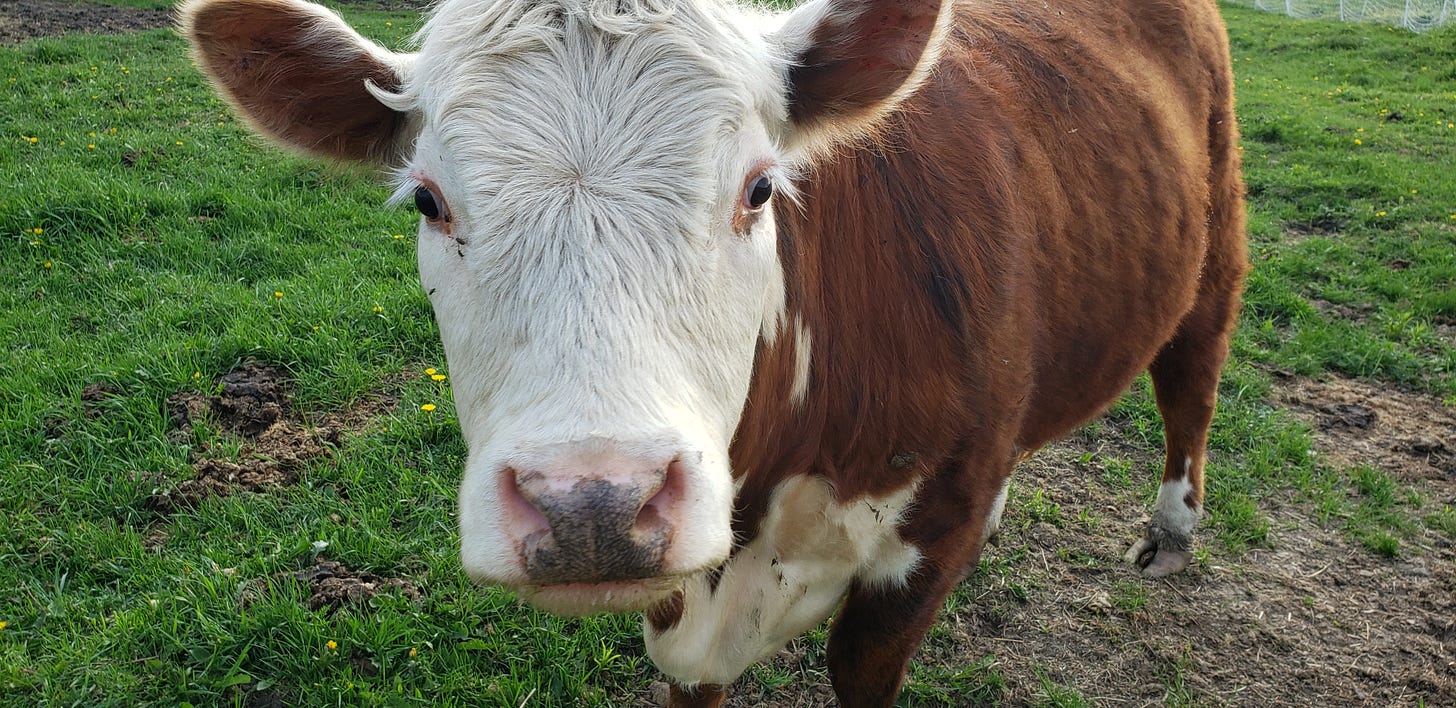Lessons from Vermont's On-Farm Slaughter Battle
(How I learned about corporate-government food control)
The optimum time to slaughter grass-fed livestock is when the grass is of peak nutritional quality, generally in June in Vermont. This maximizes the healthy fats and nutrient content (and flavor!) of the animals, creating the healthiest meats possible. At slaughter time, animals in Vermont can be slaughtered in a federal facility, or by an itinerant slaughterer at the farm, called “on-farm slaughter.” If slaughtered on-farm, the halves or quarters of beef, sheep, pigs and goats are transported to a state custom processing facility to be hung in a cooler awaiting processing.
And so in the spring of 2016 I put an ad on craigslist to sell halves of beef, as we had done in previous years. We lived on a dead-end dirt road in Irasburg, with only two houses on the road beyond ours. So when a small white car slowed in front of our house and turned into the driveway, I walked out to meet the occupant—a meat inspection official from the State of Vermont named Eric.
Eric pleasantly explained that he was there to inform me that under Vermont law it was illegal for me to sell only halves of beef if they were slaughtered on-farm, and that I could only sell whole animals. (How he had my address I don’t know, as I had not input my location on craigslist…). I was puzzled and said “But farmers have been doing this in Vermont for decades. Most people can’t afford or store (two full-size freezers required!) a whole cow. How does limiting my sales improve public health and safety?”
Eric patiently and politely advocated for the State’s position, managing to disentangle from my pressing questions after more than an hour. (I relate the tale at greater length in my upcoming book). But I was very upset by his visit, as my immediate thoughts were of the wonderful people whose entire way of life and livelihood is dependent on on-farm slaughter. Dave McCoy had slaughtered animals with me for almost twenty years, and Phil Brown in Glover had processed most of them.
On-farm slaughter and local processing has existed in Vermont for centuries. This support system allows farmers to process animals efficiently for all. But over the last century, federal power—and large, corporate food producers and processors—have increasingly displaced these local agricultural traditions with an ever-more-centralized (and ever more distant from the consumer) meat “industry.”
The short-term benefits of this conversion have included uniformity of product, some oversight or improvement of food safety (with many countervailing new problems), just-in-time availability, and lower prices. But long term there are many downsides.
In addition to increases in animal antibiotics and dubious feedstuffs (cows are fed body parts of dead cows even now, legally), large-scale industrialized rearing of animals often occasions inhumane conditions and less-than-ideal slaughtering set-ups. No method of slaughter is more humane than on-farm, where the animal is not stressed by trucking, a strange environment and people, and alarming smells. Farm animals cannot be justified as pets, but should be granted the respect of humane treatment and slaughter. Many religious slaughter traditions focus on gratitude and respect, and employ strict rules not just of prayer but of slaughter method to ensure the animal does not suffer.
The community of animal slaughterers and local processors is the foundation of local food security as well as the agricultural economy. During COVID, many people began raising animals for food, exposing a huge shortfall of slaughtering capacity, including in Vermont. Additionally, COVID cases in U.S. meat processing plants caused their closing, and meat shortages and price surges quickly ensued—that just-in-time inventory miracle is also a grave vulnerability of modern food distribution.
So after Eric left my small Irasburg farm, I was steaming a bit on behalf of Dave and Phil, and other hard workers for farmer and consumer. I began to do some research about these new laws, and learned that not only were new restrictions being implemented against on-farm slaughter, but that the practice was to be banned two years later in what is called a “sunset” provision: the statutes permitting on-farm slaughter would automatically lapse, and the practice would be outlawed.
Phil Brown earned nearly half of his gross custom processing revenue from on-farm slaughter. Dave McCoy more like 100%. The more I looked at the strained and counter-intuitive justifications offered by the government to limit and regulate on-farm slaughter traditions, the more I saw it had to be about money because it surely wasn’t about health. E Coli and other meat infections largely occur in the industrial food supply, where sickly cows are ground together by the thousands into thousands of tons of ground product that is distributed to tens of thousands of humans. Local meat is low volume, and doesn’t travel far.
I came across Dave Gumpert’s book “Life, Liberty, and the Pursuit of Food Rights: The Escalating Battle Over Who Decides What We Eat” (to which now I would add Attorney Baylen Linnekin’s “Biting the Hands That Feed Us: How Fewer, Smarter Laws Would Make Our Food System More Sustainable”). Dave traces the infiltration of state agriculture departments by policies from federal regulators offering sizable subsidies to states that implement stricter regulations against small producers. Oddly, this benefits large food producers, who tighten market share by imposing regulatory and compliance costs on small producers. And also state bureaucratic agencies, who secure long-term federal funding to expand their size and reach, providing funding for more staff, like Eric.
I conferred with my farmer bride, Jackie, who agreed that we needed to fight these new laws, on behalf of the slaughterers and processors, but also for self-reliance, and for humane animal practices. There was nothing on the state’s side in these regulations, and everything to hurt local, independent agriculture.
I drafted a letter to Eric at the Vermont Agency of Agriculture, Food and Markets in which I told him I would not abide by unconstitutional laws restricting my business and that of others without sufficient justification. I would continue to sell halves of beef as I had in the past, and his Department could arrest me if they chose. I then called a press conference and announced my civil slaughter disobedience.
The Agency initially began to investigate me, and visited one of my customers at home, as well as poked around with questions at processors. But as more farmers and supporters got on board and we descended on the State House, the inquiries stopped.
I testified at a Senate Agriculture Hearing, presided over by Dave Zuckerman. Many farmers joined me, as well as processors and slaughterers – Phil Brown was there. Additionally, I joined the Farm-to-Consumer Legal Defense Fund, and Rural Vermont, and teamed up with a food rights lawyer named Dave Berg. Dave Gumpert was supportive, and carried my/our battle nationally on his blog.
There is a longer story here (it’s in the book), but the end result was that the slaughter law changes did not go into effect, and the sunset provision was repealed before it was triggered. More, the laws were relaxed so that Vermont farmers could sell halves and quarters of animals, allowing a smaller, more affordable sale to some customers.
There is money in farming and food production, and there always has been. Even here in Vermont one can see how government and large economic interests have long coordinated policies that unfairly compromised small-scale agricultural ventures in favor of larger scale. Now farms are being blamed for climate change, because they are “too big.” But the globalists seek to make them even bigger, and switch us all to a diet of soy, corn, and other plants, and eliminate animals altogether.
That’s why raising an animal for home use, or buying local meat from a farmer you trust, is the way to rebuild community food resilience, and oppose those who seek to control every aspect (profit) of our lives….. We are not done fighting for our food rights, including the liberty to humanely slaughter our own animals.








"No method of slaughter is more humane than on-farm, where the animal is not stressed by trucking, a strange environment and people, and alarming smells."
A little off topic (maybe not)... This is why, when my dogs get old and near death, I put them down at home myself rather than a scary ride to the steel table at the vets. In each case, the pup didn't get a last meal, because it was too sick to eat.. A sure sign it's time to go.
Visualize an X between the eyes and ears, tell them you love them, and thanks, and put a 9mm at the center. Off to dog heaven.
Bury them, and feel terrible for awhile. We owe them that much.
Wow. Excellent story! Thanks for taking action that made a positive change. I am buying a copy of your book. Peace.